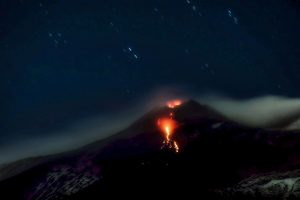
Mount Etna in southern Italy is one of the most active volcanoes on Earth, while the Hyblean Volcanoes, located further south, are extinct today. An international team of scientists with the participation of the GFZ searched for the source of magmas of Etna and examined why the ground south of Etna does not emit lava anymore. The results have now been published in the scientific journal Earth & Planetary Science Letters.
Volcanic eruptions and earthquakes most frequently occur alongside of tectonic plate margins. Some volcanoes, however, also arise within a plate; researchers refer to this as “intraplate volcanism”. Well known examples are the chain of islands of Hawaii or the Canary Islands. The volcanoes in Eastern Sicily are of the same type. For about five hundred thousand years now, Etna, a mountain of 3300 meters height, is an active volcano. The Hyblean Volcanoes, however, that were active until about one million years ago, form a mountain range on the southernmost edge of Sicily.
Movements in the deep migrate volcanoes
The scientists modelled the pathways of magma below the Hyblean Volcanoes and Etna, down to the Earth’s crust-mantle boundary in about 30 kilometers depth. The model shows: Magma pathways, also referred to as dikes, both for Etna and the Hyblean Volcanoes all bend to the East and meet with the crust-mantle boundary below the Malta Escarpment. The Malta Escarpment is a system tectonically active now for hundreds of millions of years. It stretches alongside the eastern Sicilian coastline for more than three hundred kilometres, far into the Mediterranean Sea. Often, earthquakes originate in this region. Over the past ten million years, the Earth’s crust in this region was compressed and expanded in different directions again and again.
These movements together with a deepening of the fault scarp led to bent, not vertical, magmatic dikes. Over time, this also resulted in a northwestward migration of active volcanism. Eleonora Rivalta, GFZ section Physics of Earthquakes and Volcanoes, co-author of the study: „Our findings show that Etna and the Hyblean Volcanoes represent eruptions of different ages of the same volcanic system.“ In the future, similar models may be applied to other regions to show where origins of magmas are and how dikes develop over time. (ak)
Reference:
Neri, M., Rivalta, E., Maccaferri, F., Acocella, V., Cirrincione, R., 2018. Etnean and Hyblean volcanism shifted away from the Malta Escarpment by crustal stresses. Earth and Planetary Science Letters, Volume 486, 15-22 pp. DOI: 10.1016/j.epsl.2018.01.006
Note: The above post is reprinted from materials provided by Helmholtz Centre Potsdam/GFZ German Research Centre for Geosciences.










